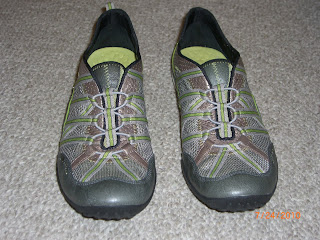
Pictured above (New Balance WR10WC2 featuring innovative RevLite midsole, Vibram road outsole, and 4mm heel to toe drop)
SUBITTED BY: Jennifer Wong, C. Ped, New Balance NBRx Business Development Rep
I am often asked “will minimal shoes work for me” and the answer I always give involves a discussion about heel to toe drop and Good Form Running technique. Most people do not know that minimal shoes have a very different heel to toe drop (0 to 4mm drop) compared to regular running shoes (8-13mm drop). What does that mean? In an exaggerated example, think of the difference between wearing a wedge and a ballet flat. The ballet flat is thinner in the forefoot, midfoot and heel and will stretch out your Achilles tendon and not absorb as much shock compared to the wedge. In order to avoid excessive strain on the balls of your feet and your Achilles while using minimal shoes, you will need to change your running form by landing more mid foot versus the traditional heel striking, landing softer with a slight bend in your knees, shortening your stride and significantly increasing your cadence (to 180 steps per minute). Most importantly, make sure to gradually transition into a minimal shoe by using this type of shoe for only 10% of your total mileage for the first few months. The WR10 is a good starting point since it has a thin midsole to give some shock absorption compared to extreme minimal shoes with no midsole.
Ice skaters, swimmers, gymnasts, golfers, tennis players, etc are all taught proper technique for their sports, but runners, whether occasional joggers or elite athletes, are never taught how to run. As a company dedicated to helping more people make running an ongoing part of their lives, New Balance recognized that a significant cause of running-related injuries was that, when it comes to form, most runners have been left to their own devices, resulting in gaits that may resist forward momentum and create unnecessary strain. New Balance has partnered with Good Form Running (developed by the well-known Michigan running store, Playmakers and Olympian Grant Robison) to help more people make running a less-painful, more enjoyable, part of their lives. Good Form Running is comprised of four steps that work together to keep you on the road, helping you to run longer, faster, and more comfortably.
Check out http://www.newbalance.com/Good-Form---What-Is-Good-Form/good_form_what_is_good_form,default,pg.html to view the Good Form Running video and http://www.newbalance.com//NB-Minimus/minimus,default,pg.html to see the newest selection of Minimus shoes from New Balance.










